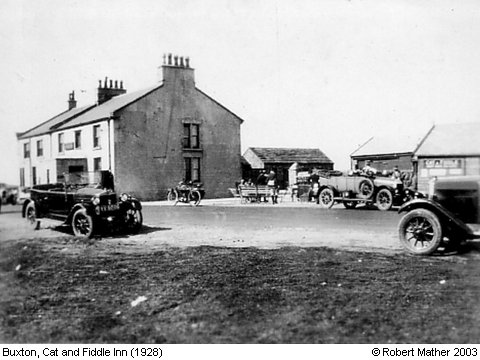Cat and Fiddle Inn, Buxton (1928)
One of Derbyshire's notorious landmarks, the ‘Cat and Fiddle Inn’ enjoyed a reputation as the highest Licensed House in England, being 1690 feet above sea level, but the Tan Hill Inn in Cumbria has more recently been discovered to be higher. Some very intriguing theories exist for its naming. One theory suggests it is a corruption of the name ‘Catherine Fidelis’ - Catherine of Aragon, the first wife of Henry VIII - and I have to admit this one does rather appeal to me, in suggesting a definite history for its origin. Less appealing is a suggestion of ‘Cat’ being Catherine, the wife of the Tsar of Russia, Peter the Great, although it is not then clear how ‘Fiddle’ became appended, nor what she may have had to do with events in England! A further theory nearer to home suggests it was named for one of the eccentric Dukes of Devonshire, who passed along this road on his way to and from Buxton and stopped at the summit on a regular basis to play his violin![1] Another theory, which is on the face of it more plausible, as it suggests a common pastime which could have taken place at public houses before the more modern amusements of the one-armed bandits and juke box arrived! The game of ‘Trap Ball’ involved the use of a ‘cat’, or tapered stick, and perhaps the Inn was also notorious for its fiddle players providing the accompanying music? Ahem, so ‘The Devil (not only) went Down to Georgia’ but down to Buxton too…[2] However... whilst this theory is tempting to believe, as many place-names are derived from customs associated with them, some further investigation into the game rules it out as one to be played indoors! It was mentioned as an early bat-and-ball game on what was formerly the SABR UK (Society for American Baseball Research) web site, which related several descriptions. Specifically, on their site in one piece entitled ‘The Chicken or the Egg ?’:- “This game is recorded as being played at least
as long ago as the 14th century, being especially associated with Shrove
Tuesday festivities. The game is the same in principle as baseball or
rounders, but the ball was not thrown. Instead, it was projected toward
the hitter by means of a miniature version of the type of catapult used at
that period to hurl cauldrons of molten lead at one's military
adversaries. This medieval pitching machine consisted of a spoon suspended
between two uprights; the thin, or handle, end of the spoon being struck
downwards thus slinging the ball at the batter. Truly, there is nothing
new under the sun.” On the other hand, we have Inns named ‘The Cricketers' Arms’, so perhaps I'm being precipitate in ruling it out on the basis of playing outdoors! Alternatively, it may be simply derived from the Nursery Rhyme - ‘Hey Diddle Diddle, The Cat and the Fiddle’, as depicted on the carved stone plate now on the wall, which may well be contemporary with its founding, as it may not be as old as its reputation might suggest. The Inn can be dated with certainty to the early 19th century (1813, according to a Wikipedia article)[3], so it predates the building of the ‘new’ A537, in 1823. One does however wonder if it was a replacement for an earlier building, which had been a Coaching Inn, since the old Macclesfield to Buxton turnpike road passed behind (to the north of) the present site, following a route down to Derbyshire Bridge and along the Old Macclesfield Road to Burbage. On the other hand, “a traveller on the new turnpike in 1831 described the Cat and Fiddle as ‘a newly erected and well accustomed inn or public house’; built by John Ryle, a Macclesfield banker, it must have been a welcome haven for early travellers on these high moors”,[4] so perhaps not… (Information provided by Rosemary Lockie) References This image is one of a collection of photographs taken during a touring holiday in the summer of 1928.
Image contributed by Robert Mather on 4th February 2003.
|
||
